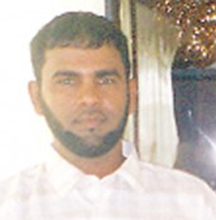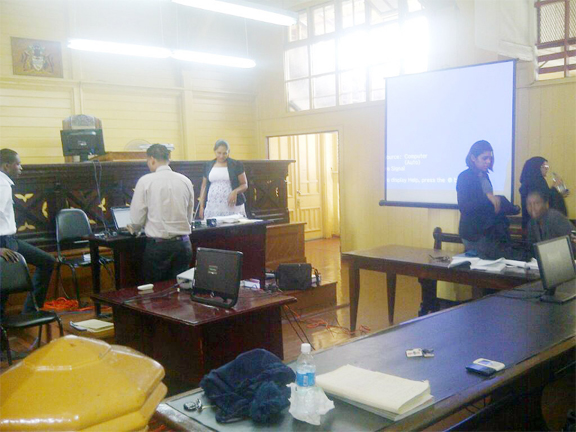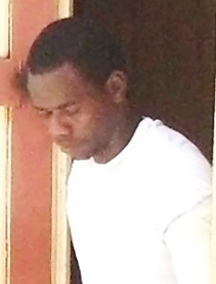History was made in Guyana’s judicial system yesterday when Justice Navindra Singh allowed evidence to be taken via video conference from the main witness in a murder trial now living in the United States.
Bibi Rameena Hydar Alli, who lives in New York, testified from the Guyana Consulate via the audio-visual link about the events of July 24, 2008, when her husband Akbar Alli was shot dead on Brickdam during a robbery.
The woman, who was with him at the time of the fatal attack and is regarded as the main witness in the case, positively identified Rondell Bacchus, the accused, during her three-hour testimony. An IT technician was on hand to operate the equipment and there were few technical glitches. The image of the witness was a bit distorted but when she spoke, her words were clear.

The use of the technology is a first in a criminal matter and comes at a time when there has been growing concern over the absence of witnesses due to migration. The Evidence Act was amended in 2008 to permit videoconference testimony but it had not been utilised in a criminal trial until yesterday. The technology was first utilised in February, 2011 during an Amerindian land rights case to facilitate the testimony of UK Professor Audrey Butt-Colson of Oxford University.
The Director of Public Prosecutions (DPP) Shalimar Ali-Hack, who was on hand to witness the historic event, was later quoted in a statement from her Chambers as saying that the use of the modern technology would allow the state “to obtain crucial testimony” of witnesses who have not only migrated outside of the jurisdiction, but of those who are no longer at the same location in Guyana that they were at the time of the incident. “This audio/visual link is not only applicable to be used in the High Court (in Demerara), but also in the Magistrate’s Courts,” she further said, while adding that it will ensure speedy trials.
When the murder trial resumed yesterday, prosecutor Konyo Thompson, who is leading the state’s case with Dhanika Singh, reminded the court of an earlier application for evidence to be taken from Alli via video conferencing, in accordance with the Evidence (Amendment) Act of 2008.
She said that the necessary equipment was set up by the registrar and that the witness was at the Consul General’s Office in New York.
Justice Singh stated that his ruling up to that point was that based on an examination of the equipment, it was of a sufficiently good quality to accept evidence. He then indicated that he wanted to hear objections from Bacchus’s attorney, Peter Hugh, before he made his final ruling.
Hugh indicated to the court that he had no objection to the technology being used since the court was satisfied with it but he was concerned that there was only one source transmitting the local feed to the witness. He said that for future instances he would prefer that there be several sources so that the witness can have a wider view of the courtroom, inclusive of the judge, jury, prosecutor and accused person. “If you are sufficiently satisfied then I have no objections to this being used,” he told the judge.
Responding to queries as to why the witness could not attend the hearing, Thompson explained that not only was she out of the jurisdiction but there were also personal reasons preventing her from attending. Thompson indicated that it would cost the state less to use the technology than to “bring her then take her back.”
The court was also told that it would be very difficult at this point for Alli to get leave from a job which she had recently started. “We had to write to her new employer to get her to leave to go to Consul General’s office,” the prosecutor noted.
According to Thompson, the technology was being used in the interest of justice and to prevent delays. She said that it is also in the interest of the accused that the evidence is taken in such a way, instead of having him incarcerated until the witness is available to attend.

After hearing all sides, Justice Singh said that the court was satisfied that the audio-visual link was “the most convenient way available” to take the evidence. “This is in the interest of all parties that we will go ahead and receive her evidence via the audio visual linkage,” he said, before explaining to the jury what was happening and what they should expect.
Robbery
Moments before Alli began her testimony, Guyana’s Consul General to New York Brentnol Evans identified himself and he held the Quran on which Alli place her hand as the High Court Marshall swore her in.
Led in her evidence in chief by Thompson, Alli recalled the events of July 24, 2008, when her husband was fatally shot.
She said that they left their home for Georgetown around 9:45am that day in a car that was driven by her husband.
They arrived in the city around 10:05am and went straight to the Environment Protection Agency (EPA), where they spoke with someone briefly before proceeding to Maraj building on Charlotte Street, where purchases were made. From there, Alli said, they headed to Guyana Stores to collect a cheque from a man to whom her husband supplied scrap metal. The man, who was waiting outside, handed over the cheque for $3M, which they subsequently cashed at Demerara Bank on Camp Street. According to Alli, $200, 000 was deposited into the savings account they had at the bank and they later left with the remaining $2.8M, which was in a green “Diesel side bag.” They travelled to Scotia Bank on Carmichael Street, where $650,000 was deposited into her husband’s chequing account, before they headed back to the EPA to drop off a letter.
Alli testified that they then went to King Solomon Enterprises on Brickdam. She said that they both exited the vehicle and she was carrying the bag with the remainder of the money inside. She said her husband was a little ahead of her as they crossed the road and she saw a man walking towards her. She said that the man was Afro-Guyanese with low cut hair and was medium built and approximately 5’6’’ to 5’7’’ tall. When he reached close to her, she said, “he lift his shirt and he took out a gun from his waist. He raised it to my stomach and he said, ‘gimme this bag’ and he pulled it away from me.” She said he took the bag containing the money.
At this point, Alli testified, the man started to run towards someone waiting on a small, black motor cycle. “…I kept looking at him,” she said, while adding that she heard the man shout out to the robber. “He [her husband] took a few quick steps towards the man who had robbed me,” she recalled. Her voice was shaky at times and one could have seen her rubbing her hand nervously.

She said that as her husband moved towards the robber, who was still holding the gun, the man fired a shot before jumping on the motorcycle, which headed east then turned right into a nearby street heading south.
Alli said her husband ran to her and she saw a hole with blood smeared around it on his neck. As she stood screaming, her husband ran to their parked car and a man came out of the King Solomon building and drove them to Georgetown Hospital. She was later informed that her husband was dead.
During additional questioning by Thompson, Alli said that the incident occurred around 12:30 pm and she was able to get a good look at the robber’s face, since she was looking at him for approximately three minutes.
On September 11, 2008, she added, she went to the CID headquarters for an identification parade, where she identified the suspect from seven men who were each holding a number. “I looked at each of them carefully and I realized that the person holding “number six” was the man who robbed me and shot my husband,” she said, while adding that she was in that room for five minutes and realised he was the person after two to three minutes. She waited an extra few minutes because she wanted to have “a further good look at him,” she explained.
Even though she was trembling and nervous when the gun was held to her, Alli said, it did not affect her view of the robber. “I saw him even before he put the gun to me,” she stressed.
Alli was then told that the webcam transmitting the feed to New York would be moved very slowly around the courtroom and that she was to indicate if she saw the robber. That was done and it appeared that the witness had some difficulties. At one point, she said that she could not see clearly behind “the spindles.” Later, she said that the person who robbed her and shot her husband was sitting behind the spindle with a white shirt. “The man with folded arms…. I think that he is wearing a tie,” she said, referring to Bacchus, who was dressed in a white shirt with tie and a pair of cream coloured pants.
Absolutely sure
During the cross-examination by Hugh, Alli said that the events of the day of the attack were fresh in her mind when she gave the two statements to police. The first statement was given after the shooting and the other after the identification parade. She said that on July 24, she indicated to the police that she could have identified the robber by the way he said, “Give me this bag.” She agreed that on the day of the identification parade, none of the potential suspects uttered those words.
Alli said that when the robber lifted his shirt, she saw what she knew was a gun. But she added that she could not describe it though she knew that a part of it was silver. She said she would have seen the gun for about 30 seconds and she also admitted that when the gun was placed to her stomach, she was not looking at the robber’s face.
When it was suggested to her that when the man was running away she could not see his face, Alli explained that she could since nothing was blocking his face. She added that at that point she was mostly seeing the side of his face not his back, since he was going in a north eastern direction.
Alli later testified that all the persons on the identification parade had more hair that the person who had robbed her. She said that she was certain it was the person who she had picked out. Asked why she took so long to look at him, Alli said that she had to look at seven men.
She said that when she made the identification, she was the only person in the room adding if the person was not there she would not have picked the accused out.
When Hugh suggested that she had initially told the police that the robber was 5’9” to 6’ tall, Alli admitted that she may have said that. “I could not be certain about his height but that does not change the fact that I did see his face,” she said. She added that she may not have been paying attention to the man who was walking up to her but she did look at him. The entire ordeal lasted three to five minutes, she added, while saying that she saw the man at all times. She said that she could not recall mistaking anyone’s identity and in this case she did not mistake the identity of the robber. “I am absolutely sure that that is the person who robbed me and shot my husband,” she stressed.
Bacchus had been jointly charged with Andrew Morris. The DPP had subsequently withdrawn the charge against Morris due to the lack of evidence.
The case continues today.





